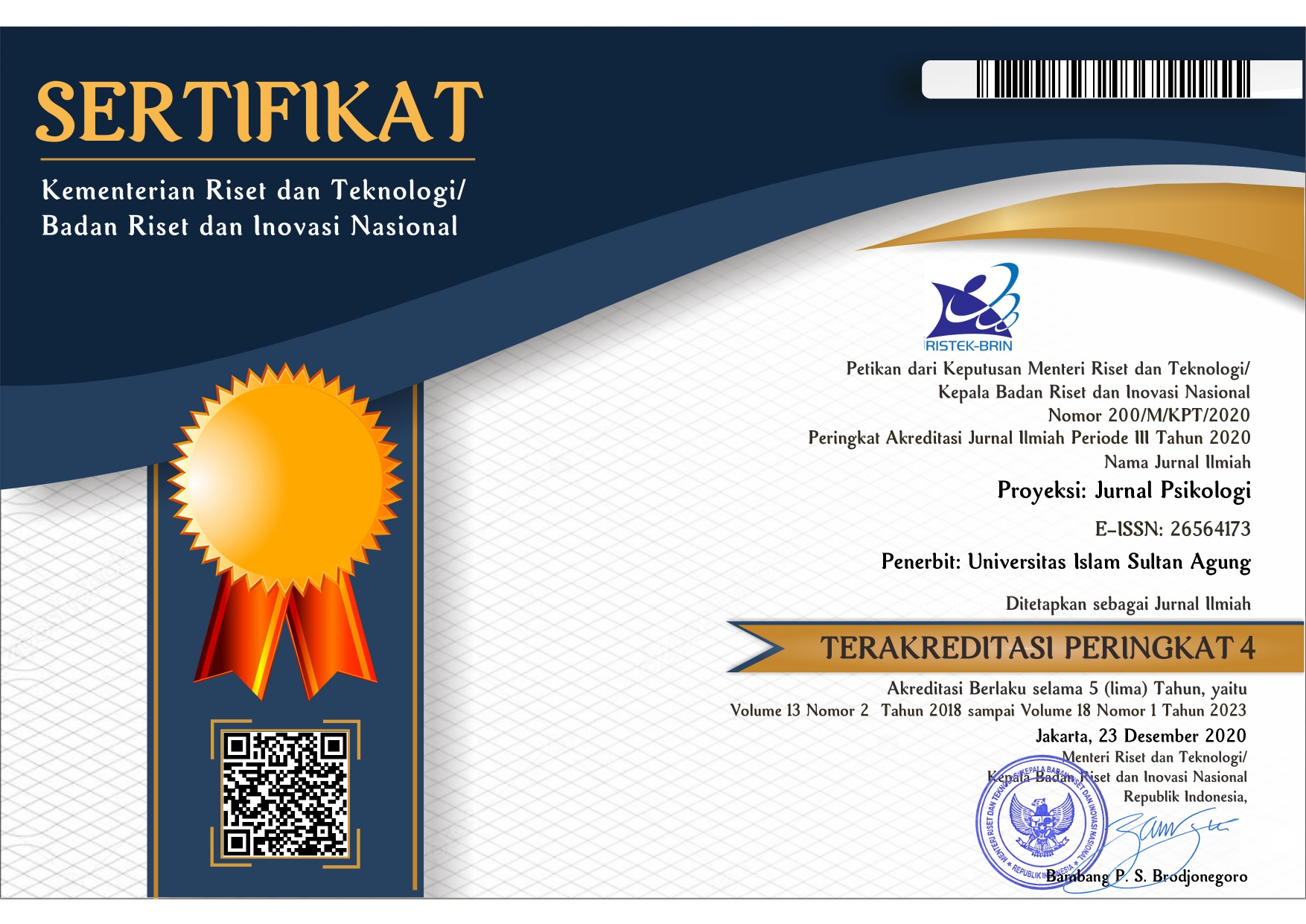PUBLIC DISPLAY OF AFFECTION SEBAGAI BENTUK EKSISTENSI DIRI REMAJA PENGGUNA FACEBOOK
Abstract
Media sosial memberikan peluang besar bagi remaja untuk membangun dan mengelola jaringan pertemanan, termasuk di dalamnya hubungan romantis. Konflik dorongan untuk otonom dengan aturan orang tua seolah terselesaikan dengan hadirnya media sosial. Facebook memberi ruang bagi remaja untuk menunjukkan identitas dirinya. Namun luasnya pertemanan, seringkali muncul ketegangan untuk mengelola hubungan yang sudah ada. Ketegangan besar terjadi dalam hubungan romantis, karena ada kebutuhan yang besar untuk mengumumkantentang keberadaan sebuah komitmen atau ikatan kasih sayang, yang sering dikenal dengan public display of affection (PDA). Seberapa penting PDA dilakukan, mengapa, dan bagaimana dampaknya mencoba diijawab dalam penelitian ini dengan menggunakan pendekatan gounded yang melibatkan 10 orang remaja usia 18-20 tahun. Penelitian ini mampu memberikan penjelasan tentang dinamika hubungan antara faktor-faktor yang mempengaruhi PDA dan dampak yang dirasakan pada audiens. Kebutuhan akan eksistensi dan popularitas, pengaruh teman sebaya, tekanan pasangan dan kepercayaan diri yang rendah mendorong PDA. Sedangkan norma keluarga dan religius menghambat PDA. PDA yang belebihan dirasa tidak pantas diunggah pada ranah publik. Remaja perlu mempertimbangkan hal ini.Â
Â
Kata kunci: media sosial, facebook, hubungan romantis
Keywords
Full Text:
XMLReferences
Ardi, R., & Maison, D. (2014). How do Polish and Indonesian disclose in Facebook? Differences in online self-disclosure, need for popularity, need to belong and self esteem. Journal of Information, Communication and Ethics in Society, 12(3), 195–218. https://doi.org/10.1108/JICES-01-2014-0006
Bazarova, N. N. (2012). Public Intimacy: Disclosure Interpretation and Social Judgments on Facebook. Journal of Communication, 62(5), 815–832. https://doi.org/10.1111/j.1460-2466.2012.01664.x
Bazarova, N. N., & Choi, Y. H. (2014). Self-disclosure in social media: Extending the functional approach to disclosure motivations and characteristics on social network sites. Journal of Communication, 64(4), 635–657. https://doi.org/10.1111/jcom.12106
Boyd, D. (2014). It ’ s complicated: the social lives of networked teens. London: Yale University Press.
Brake, D. R. (2014). Sharing our lives online risk and exposure in social media. London: Palgrave Macmillan.
Bruss, O. E., & Hill, J. M. (2010). Tell Me More: Online Versus Face-to-Face Communication and Self-Disclosure. Psi Chi Journal of Undergraduate Research, 15(1), 3–7. Retrieved from http://search.ebscohost.com/login.aspx?direct=true&db=a9h&AN=52258666&site=ehost-live
Christopherson, K. M. (2007). The positive and negative implications of anonymity in Internet social interactions: “On the Internet, Nobody Knows You’re a Dog.†Computers in Human Behavior, 23(6), 3038–3056. https://doi.org/10.1016/j.chb.2006.09.001
“Civil Unions†Pilihan Status Baru Facebook. (2011). Retrieved October 11, 2011, from https://www.antaranews.com/berita/247355/civil-unions-pilihan-status-baru-facebook
Creswell, J. W. (2013). Qualitative Inquiry and Research Design: Choosing Among Five Approaches (Third). Los Angeles. CA: Sage.
Derlega, V. J., & Chaikin, A. L. (1977). Privacy and Self-Disclosure in Social Relationships. Journal of Social Issues, 33(3), 102–115. https://doi.org/10.1111/j.1540-4560.1977.tb01885.x
Gerrard, M., Gibbons, F. X., Houlihan, A. E., Stock, M. L., &
Pomery, E. A. (2008). A dual-process approach to health risk decision making: The prototype willingness model. Developmental Review, 28(1), 29–61. https://doi.org/10.1016/j.dr.2007.10.001
Gillberg, C. (2014). Commentary : PDA – public display of affection or pathological demand avoidance? – reflections on O ’ Nions et al . (2014 ). Journal of Child Psychology and Psychiatry, 55(7), 769–770. https://doi.org/10.1111/jcpp.12275
Joinson, A. N., & Paine, C. B. (2012). Self-disclosure, Privacy and the Internet. In Oxford Handbook of Internet Psychology (pp. 235–250). https://doi.org/10.1093/oxfordhb/9780199561803.013.0016
Joinson, A. N., Ulf-Dietrich, R., & Buchanan, T. (2010). Privacy, Trust, and Self-Disclosure Online. Human-Computer Interaction, 25(1), 1–24. https://doi.org/10.1080/07370020903586662
Jordán-Conde, Z., Mennecke, B., & Townsend, A. (2014). Late adolescent identity definition and intimate disclosure on
Facebook. Computers in Human Behavior, 33, 356–366. https://doi.org/10.1016/j.chb.2013.07.015
Kementerian Komunikasi dan Informatika. (2014). Retrieved September 7, 2014, from
https://kominfo.go.id/index.php/content/detail/3834/Siaran+Pers+No.+17-PIH-KOMINFO-2-2014+tentang+Riset+Kominfo+dan+UNICEF+Mengenai+Perilaku+Anak+dan+Remaja+Dalam+Menggunakan+Internet+/0/siaran_pers
Krämer, N. C., & Winter, S. (2008). Impression Management 2.0: The Relationship of Self-Esteem, Extraversion, Self-Efficacy, and Self-Presentation Within Social Networking Sites. Journal of Media Psychology, 20(3), 106–116. https://doi.org/10.1027/1864-1105.20.3.106
Lee, G., Lee, J., & Kwon, S. (2011). Use of social-networking sites and subjective well-being: a study in South Korea. Cyberpsychology, Behavior and Social Networking, 14(3), 151–5. https://doi.org/10.1089/cyber.2009.0382
Madrah, M., & Adnjani, made D. (2014). Identitas Diri Remaja Melalui Status Sosial Facebook. Makna, 4(2), 181–198.
Mod, G. (2010). Reading romance: The impact Facebook rituals can have on a romantic relationship. Journal of Comparative Research in Anthropology and Sociology, 1, 61–77.
Peluchette, J., & Karl, K. (2008). Social networking profiles: An examination of student attitudes regarding use and appropriateness of content. Cyberpsychology & Behavior, 11(95–97).
Puspitarini, M. (2014). Gunakan Sosmed untuk Promosi Hingga Bangun Reputasi : Okezone News. Retrieved September 20, 2014, from
https://news.okezone.com/read/2014/09/03/373/1033784/gunakan-sosmed-untuk-promosi-hingga-bangun-reputasi
Remaja di Malang Dibekuk Usai Upload Foto Intim dengan Pacar. (2014). Retrieved December 30, 2014, from https://news.detik.com/berita-jawa-timur/2788134/remaja-di-malang-dibekuk-usai-upload-foto-intim-dengan-pacar
Rubin, A. M. (2009). Uses and Gratification Perspective on Media Effects. In J. Bryant & M. B. Oliver (Eds.), media Effects Advances in Theory and Research (Thirth Edi, pp. 165–184). London: Routledge.
Santor, D. A., Messervey, D., & Kusumakar, V. (2000). Measuring Peer Pressure, Popularity, and Conformity in Adolescent Boys and Girls:rPredicting School Performance, Sexual Attitudes, and Substance Abuse. Journal of Youth & Adolescence, 29(2), 163–182. https://doi.org/10.1023/a:1005152515264
Severin, W., & Tankard, J. W. J. (2005). Teori Komunikasi: Sejarah, Metode, & Terapan di Dalam Media Massa (5th ed.). Jakarta: Kencana.
Utz, S., & Beukeboom, C. J. (2011). The Role of Social Network Sites in Romantic Relationships: Effects on Jealousy and Relationship Happiness. Journal of Computer-Mediated Communication, 16(4), 511–527. https://doi.org/10.1111/j.1083-6101.2011.01552.x
Utz, S., Tanis, M., & Vermeulen, I. (2012). It Is All About Being Popular: The Effects of Need for
DOI: http://dx.doi.org/10.30659/jp.10.1.66-82
Refbacks
- There are currently no refbacks.

Proyeksi by http://jurnal.unissula.ac.id/index.php/proyeksi/ is licensed under a Creative Commons Attribution-ShareAlike 4.0 International License.

